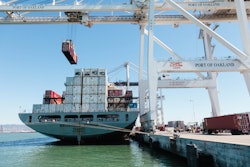
Blank sailings between the United States and China are predicted to surge in October, with 67 blank sailings planned for vessels going from China to the United States and 71 planned for vessels going from the United States to China. This exceeds COVID-19 pandemic levels, according to data released by project44.
“One of the clearest indicators of this shifting landscape has been an increase in blank sailings throughout 2025, reflecting reduced demand for ocean capacity as the cost to import goods into the United States rises,” the report says. “These capacity cuts have been concentrated on certain lanes and carriers, particularly on U.S.-related trade routes most directly impacted by tariffs and geopolitical tensions. However, as tariff rates have begun to stabilize, early data suggests that U.S. companies have not made wholesale changes to their trade strategies. The overall proportions of imports and exports remain broadly consistent with 2024 levels year-to-date, indicating that for now, most sourcing patterns remain intact.”
Key takeaways:
· Some short-term tactical adjustments are evident. For example, Chinese weekly import volumes show both pull-forward ordering ahead of tariff hikes and delayed shipments when rates were at their peak. Yet on a net basis, U.S. import volumes are comparable to 2024, underscoring that the biggest changes so far have been in the timing of shipments rather than the structure of supply chains.
· Longer-term shifts, such as moving manufacturing to other countries or reshoring production to the U.S., remain under close watch. These decisions require significant capital investment and multi-year timelines to execute. Until such changes materialize, the additional costs imposed by tariffs are being absorbed somewhere along the chain, whether by overseas vendors, U.S. importers, or ultimately, the end consumer.
· Year to date, the trans-Pacific, China to the West Coast saw a 46% jump in blank sailings year over year, while Southeast Asia to the West Coast recorded a 41% increase. These lanes remain among the heaviest trafficked in the world, and the surge in cancellations underscores how carriers are managing weaker U.S. import demand and adjusting for uncertainty created by ongoing tariff measures. The East Coast is not insulated either: Southeast Asia to the East Coast posted a 29% rise, reflecting pressure on all major Asia–U.S. corridors.
· On the export side, lanes show even steeper proportional increases. Blank sailings from the West Coast to Southeast Asia climbed 75%, indicating that carriers are cutting capacity on U.S. export routes where tariffs, weaker demand for U.S. goods, and shifting trade flows are reducing vessel utilization. The Gulf Coast to China also emerged as a pressure point, suggesting that traditional energy and agriculture flows are being disrupted or rerouted as tariff impacts become more evident.
· While tariffs on major trade partner China have been reduced in recent months, their effects continue to ripple through supply chains. A closer look at U.S./China trade flows in 2025 reveals sharp swings tied directly to tariff actions and market anticipation. On the import side, shipments from China to the United States are trending 27% lower year-to-date compared to 2024. After modest gains in January (+1%) and February (+4%), volumes fell steeply, with declines of –38% in April, –46% in May, and –41% in September. These swings illustrate how tariffs and front-loading behavior created early-year spikes followed by sustained weakness through the summer and fall.
· In response to the U.S. tariffs, China passed their own tariffs on U.S. goods, also impacting exports from the U.S. to China. On the export side, shipments from the United States to China are under even greater pressure, trending 42% lower year-to-date. Monthly volumes have been consistently negative against 2024, with particularly steep drops of –57% in April, –53% in May, and –53% again in August. Political tensions layered on top of tariff measures are compounding the downturn, reducing demand for U.S. goods in the Chinese market.
· While tariffs have reshaped certain trade lanes, the broader proportions of U.S. imports and exports by country have seen only modest changes in 2025. This suggests that, despite political and economic headwinds, most U.S. companies have not significantly restructured their sourcing or customer base.
· On the export side, Canada, one of America’s largest export partners, stood out for a steep 7.6% year-to-date drop in its share of U.S. exports. Political and economic tensions are high between Canada and the United States, which has resulted in “Buy Canadian” movements and impacted Canadian demand of some U.S. goods like alcohol, which could be a contributing factor to the lower rate the Canada is ordering U.S. goods. China is also seeing one of the largest decreases YTD at a 1.4% decrease. Meanwhile, India (+1.9%) and Mexico (+1.4%) have posted the largest proportional export gains, likely reflecting multi-year growth trends and ongoing diversification of U.S. export markets.
· For imports, changes have been modest overall. India has recorded the largest year-over-year increase in share (+1.2%), followed by Bangladesh (+0.6%) and Japan (+0.5%), while the EU (-1.1%), Canada (-0.5%), and Indonesia (-0.5%) have all seen small declines. These shifts appear to reflect a broader trend toward supply chain diversification away from China, rather than a direct response to the 2025 tariff environment.
· However, trade tensions with India are rising, and recent monthly data shows a small decline in the proportion of imports from India (-0.4% between August and September). This suggests that while India’s overall share remains higher than last year, short-term fluctuations and tariff pressures are beginning to weigh on shipments. India is currently subject to a 25% reciprocal tariff, an additional 25% tied to Russian oil imports, and potentially another 25% linked to Venezuelan oil, exposing Indian exports to tariffs ranging from 50–75%. The new 100% tariff on pharmaceuticals effective October 1, 2025, will further undermine competitiveness, pushing total tariff exposure for some Indian goods into the 150% range. If these trends continue, it is likely that the 1.2% increase in India’s proportion of U.S. imports will continue to decrease.
· Notably, China’s share of U.S. imports remains essentially unchanged compared to 2024. While weekly data shows some volatility, especially around tariff hikes and subsequent reductions, the overall annual share has returned to last year’s baseline following an early-year surge from front-loaded orders.
· Ocean shipment data, however, reveals early signs of resourcing trends. With volumes out of China decreasing, Indonesia and Thailand are emerging as alternative suppliers, showing monthly increases of 11–81% compared to 2024 (excluding April). Both countries still face tariffs (+19% since January, plus product-specific surcharges), but demand has nevertheless grown.
· The de minimis exemption has led to an increase in work needed for e-commerce shippers to process shipments from overseas, with concerns that this will delay online orders in the ecommerce space.




















